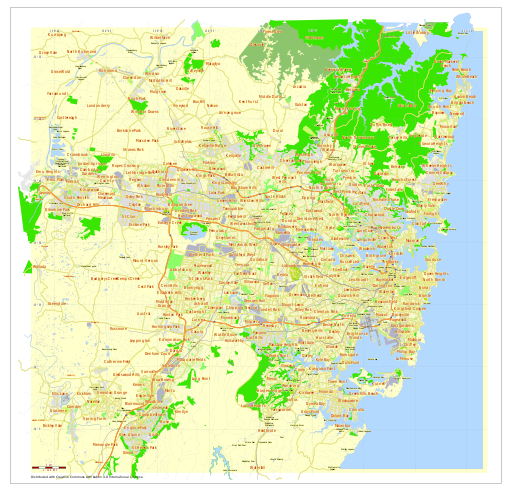Introduction
An ecosystem is a community of living organisms, in conjunction with the nonliving components of their environment (things like air, water and soil), interacting as a system. These biotic and abiotic components are regarded as linked together through nutrient cycles and energy flows.
Defining urban
Urban ecosystems comprise the built cities, towns, and urban corridors constructed by humans. Urban areas can be viewed as ecosystems in that they have many of the same functions of natural ecosystem, that is, living and non-living components interacting as a system. In considering urban ecosystems, we should try to put aside the notion that nature means only pristine natural areas. There is also nature in cities, it just tends to be a little less obvious.
Sydney Harbour
Sydney Harbour for example, in the centre of a global city, is one of the most biodiverse marine regions on the planet. It contains at least 3,600 invertebrates and about 600 fish species, including dozens of Australian endemic species. Cities themselves also act like ecosystems in that they have inputs (energy, materials and nutrient supplies), processes and outputs (waste products)
Observatory Hill Environmental Education Centre
Did you know that NSW has an urban focused DOE Environmental Education Centre in the heart of Sydney? Observatory Hill Environmental Education Centre is located in Millers Point adjacent to the Rocks, Barangaroo and the CBD. It conducts urban based environmental education programs for students from K-12. The Centre focuses on NSW Syllabus outcomes, based around key issues related to urban environments and urban ecosystems.
Location

Scientists estimate that urban areas make up only around 2.7% (3.5 million km squared) of the earth’s surface, yet over half the world’s people now live in urban areas, with most of the other half depending on them for their economic survival.
Populations
The urban population of the world has grown rapidly from 746 million in 1950 to 3.9 billion in 2014. Today, around 54 per cent of the world’s population lives in urban areas, a proportion that is expected to increase to 66 per cent by 2050. In NSW, 90% of our population live in urban areas (built up towns and cities of more than 1000 people).
Google Earth
An example of an urban ecosystem can be found around the foreshore of Sydney Harbour, near Circular Quay on Google Earth. To move out of street view level and look at the wider area click the yellow person icon in the bottom right hand corner.
Significance
Cities are the largest, most complex structures ever made. They are the central hubs of modern economies and their transport systems. Their resource use and waste discharge effects surrounding, and global, ecosystems.
Ecological footprint
Sydney for example has an ecological footprint of 26 million ha (around 7ha per person). Fossil fuel technology powers modern urbanisation, but in the coming years many cities will become vulnerable to the effects of this use through climate change, including rising sea levels and extreme weather events.
Researching urban ecosystems
By considering urban areas as part of a broader social-ecological system, scientists are investigating how urban ecosystems function and how they affect other ecosystems they interact with. In this context, urban ecosystems can be seem as being affected by their surrounding environments but critically, also affecting those environments. Knowing this provides clues as to which alternative development options will lead to the best overall environmental outcomes for the planet (often viewed as a global ecosystem).
Conservation
Human impacts
With growing population growth in urban areas, scientists are increasingly calculating human impacts on other ecosystems, particularly the value of natural ecosystem services such as:
-
provisioning (for example production of food and water
-
regulating (for example the control of climate and disease)
-
supporting (for example crop pollination; and cultural)
-
recreational benefits.
Changing views
Urban ecologists are currently promoting a revolution in how urban ecosystems operate in order to reduce our pressure on global ecosystem services. For example, urban ecologist Herbert Giradet describes the need for local and circular (closed loop) systems of waste, energy, nutrients and materials to create more sustainable cities in order to help reduce our urban ecological footprint and impact on natural ecosystem services.
Strategies
Examples of strategies to achieve this include developing renewable energy technologies, promoting collective sustainability actions (like recycling), growing food locally, mimicking natural ‘zero-waste’ ecosystems (through water recycling, composting and waste recycling), and supporting biodiversity through the development and preservation of urban parks and wildlife corridors.
Environmental education centre
Many NSW Department of Education EEC’s are located in urban areas and focus on programs and strategies to improve sustainability and reduce our urban ecological footprint.
Observatory Hill EEC is located on Observatory Hill in Sydney’s CBD, and conducts programs in and around the CDB, Sydney Harbour, The Rocks heritage precinct, and various urban development sites. It also conducts school based incursions on sustainability themes.
Focus teaching areas include investigating and promoting sustainable urban design, utilising urban parks to raise awareness of the importance of urban biodiversity and promoting school (and community) sustainability initiatives.
Other centres
Many Environmental Education Centres in NSW can also assist with studies of urban ecosystem issues.